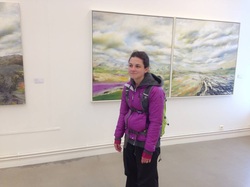
It's been a bit! As it turns out, Iceland has approximately three Wi-Fi hotspots, give or take a random gas station (they actually never have Wi-Fi, unless you have a Vodafone, or know what that is). We last left off at Hveragardi, the charming coastal town that I would have gladly stayed in for the rest of the trip. Chris, of course, had other plans, which included making me go to the above "art" gallery on our last night in Hveragardi and look at underdeveloped water color paintings instead of eating dinner first. You can tell by the way I have my backpack cinched, making me look like a depressed forty-year-old dad who let himself go, that I am not impressed with the situation.
The next day, we packed up our gear, which took disturbingly long, and set off for Selfoss, a mere seven miles away, with the hope of going farther along to a primitive campsite on the road to Hella. Unfortunately, this is when a torrential downpour made its appearance. This is in a rare break from the gray sheets.
The next day, we packed up our gear, which took disturbingly long, and set off for Selfoss, a mere seven miles away, with the hope of going farther along to a primitive campsite on the road to Hella. Unfortunately, this is when a torrential downpour made its appearance. This is in a rare break from the gray sheets.
The rain refusing to let up, we made camp at the unbelievably pleasant campsite in otherwise uninteresting Selfoss, and payed the whopping $4 to sit in a hot tub and warm our bones. It was a nice evening, which now strikes me as a piece of devil trickery designed to lull us into letting our guard down before the next day's ride to Hella.
In short, we had interminable rain and wind again, which was a bit more disconcerting than the day before because we had about 20 miles to ride instead of seven. Cold. Wet. Blustery. Trafficky. But we made it to Hella in relatively good time, which would have been better if we hadn't been charged $40 to stay at a "campsite" that was actually mostly a resort for wealthy Nordic people in dinner jackets. It was clear that our damp, neon presences were marring an otherwise idyllic stay in Icelandic horse country, so we kept our plebeian selves to our tent and left early the next day, stopping only to fraternize with the jolly gardener's sheep dogs. Then I got extremely homesick, so here's a photo of my sheep dogs.
Somewhere on the route either to Hella or to Hvollsvollur seven miles beyond, we also saw Urriga Foss. By Icelandic standards, it's apparently not terribly scenic. By Wyoming standards, though, the misty beast was massive and terrifying and gray. We stopped off to enjoy for some time, during which I was struck by the amount of people who drove up, stopped their cars, got out, took a two second picture of themselves doing peace signs or Vanna White arms in front of the falls, got back in their cars, and then drove away. Two minute interludes, at the most, and I'm pretty sure no one actually stopped and looked at the water in front of them. So odd.
To our credit, we didn't make peace signs or try to display the waterfall as if we had constructed it ourselves as a fourth grade science project. You can also tell how tired I am.
Hvollsvollur is a supply town in the Sundur Valley, in the Volcano Katla Geopark system. It was developed, along with a few other small stops, to support the farmers scattered across the area (in the midst of a volcano's war path, I might add). Though nothing but three gas stations, and probably a school somewhere, Hvollsvollur also has a delightfully Nordic museum devoted to Njal's Saga, Iceland's most cherished epic. For obvious reasons, we had to go.
Written down in the 12th or 13th century, the story lays out the true events surrounding an extremely convoluted clan feud that took place in the lands surrounding Hvollsvollur in the 900's or so. Here is what I gathered from the 30 exhibits attempting to tell the complicated story in a coherent fashion:
Gunnar and Njal are great friends and great men, both living in the area of Iceland near today's Hvollsvollur. Gunnar is a strong Viking type, representing the quintessential Icelandic pagan, while Njal is a wise and forgiving lawyer, representing Iceland's upcoming conversion to Christianity at the Althing (Icelandic Parliament) in 1000. (Recall that the story's events take place before 1000, so all representations and pieces of symbolism are evoked by the recorder, who put everything to paper in the 1200's and probably made some stuff up, in my opinion.) Unfortunately, Gunnar and Njal both have temperamental wives, and after Njal's wife offends Gunnar's wife at a dinner party by asking her to move over a bit, the wives begin having each other's slaves killed in Hammurabi-style fits of justice. The husbands keep making monetary retributions to each other until the nonsense finally stops. Sadly, a food shortage begins, and Gunnar's wife sends one of her living slaves to burgle food from another man called Otkell. Gunnar finds out and slaps her a good one, which turns out to be a bad choice because when Otkell comes to kill Gunnar, Gunnar asks his wife for some of her hair to make a bowstring and she says "Nay" because Gunnar slapped her a good one. Thus, Gunnar is dead.
Forgetting about Gunnar's fate and shifting wildly into a new story, Njal's sons go a-Viking (literally a word used in the English display) and meet a man called Kari, who joins them in a-Viking-ing. They a-Viking another ship, and find a young boy aboard. Merciful as ever (despite a-Viking and whatnot), Njal adopts little Hoskuldr as his son and goes home to Iceland, being done with a-Viking-ing for now. Hoskuldr grows up and marries Hildigunnr. Her uncle is Flosi, a leader, and he likes Hoskuldr quite a bit. Now, Njal's sons have grown jealous of Hoskuldr, as he has become a powerful chieftan, so they are urged by some non-important character to exact revenge, which they do quite violently. His widow, Hildigunnr is distraught, as are Njal (at his sons' barbarism, ironically) and Flosi (at the death of his favorite nephew-in-law). Urged on by Hildigunnr, who does some gross things with the blood of her dead husband, Flosi decides to enact revenge on Njal's family.
Peace treaties break down, bloody fighting, including some taking place on slippery ice, ensues, and finally, Flosi's men burn down Njal's house with his family inside of it. According to church lore. Njal, his wife, and his grandson chose to stay inside the house as martyrs, and covering themselves with an ox hide, died in the home. When their bodies were recovered though, it was found that they were utterly intact and preserved, save for the burnt off finger of the grandson, who had poked it through the ox hide (why?). Recall, again, that this all occurs before Iceland adopts Christianity in 1000. Anyway.
Remember Kari? No? Well, go back and read again. Kari had married one of Njal's daughters and it was his now-nine-fingered son who had died, so Kari, of course, must exact revenge on Flosi. Kari travels about the world, going as far as Rome to receive absolution from the Pope for all the a-Viking-ing he does (again, all before Iceland adopts Christianity in 1000). Flosi does the same. Kari, after receiving absolution, sees one of the arsonists in a market in Britain, and chops the guy's head off mid-sentence. So much for Heaven.
Eventually, Kari and Flosi both go back to Iceland. They meet at the Althing, money and pleasantries are exchanged, some criminal charges laid down, and suddenly Kari and Flosi have both forgiven each other and their clan feud is abruptly done. The end. Praise God.
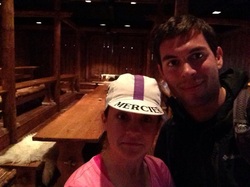
Simple as that. According to the display, Iceland's epics are the first written stories to use the literary technique of using characters' words and actions to express their identities, rather than describing them outright. A contemporary of this tradition and devoted student of the Icelandic sagas was Ernest Hemingway (the best author ever to grace this planet).
That being said...Njal's Saga is still incredibly long and painfully confusing. These people were the Borgias of the Viking world, but with maybe even more death and more complex relationships with God.
That being said...Njal's Saga is still incredibly long and painfully confusing. These people were the Borgias of the Viking world, but with maybe even more death and more complex relationships with God.
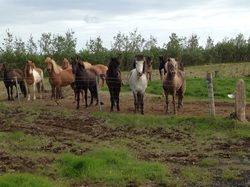
And somehow, all of this brings me to today. We are at Vestmannaeyger, the Westann Islands in English. From Hvollsvollur, we escaped the world of melodramatic Vikings and cycled into farm country, passing paddock after paddock of green grass, churlish ponies, and the intoxicating forms of uncannily Zoe-like sheep. The map showed name after many-lettered name; we assumed they were little communities, but we found them to actually be the names of the various farms we passed, there being nothing else in the area to identify how far you had gone or where to turn on the map. The road was nearly flat the entire way and the farm animals were enough to occupy us for hours of happy-go-lucky cycling to the harbor that would transport us to an otherworldly group of volcanic, chilly islands.
This was the ride we made up in our heads to make ourselves feel better for the way things actually went. To give yourself an accurate picture, imagine everything I described above...and then add a 40 mile an hour headwind that stayed with us. The whole day. Every minute. A 40 mile an hour headwind. It took us close to seven hours to complete the 25 or so miles to the ferry. Seven hours to ride 25ish miles. Geese waddle faster. It was excruciating. There's nothing else to be said for it. Our legs were, and still are, dead and we made the last ferry by sheer dumb luck and a half-witted race to the finish that left both of us rather delirious.
This was the ride we made up in our heads to make ourselves feel better for the way things actually went. To give yourself an accurate picture, imagine everything I described above...and then add a 40 mile an hour headwind that stayed with us. The whole day. Every minute. A 40 mile an hour headwind. It took us close to seven hours to complete the 25 or so miles to the ferry. Seven hours to ride 25ish miles. Geese waddle faster. It was excruciating. There's nothing else to be said for it. Our legs were, and still are, dead and we made the last ferry by sheer dumb luck and a half-witted race to the finish that left both of us rather delirious.
Here is the view from the ferry, along with some smokers. Vestmannaeyer is a group of islands that have been created, and recreated, by volcanic eruptions, and other such terrifying occurrences of seismic activity. Our present campsite sits in the crater of a blown out volcano. Jagged, finger-like cliffs stretch up around us on three sides; white seabirds have taken up residence on rock shelves and ledges, and they sail about high above us, screeching interminably while they hunt and guard their nests.
But we are here for the puffins. Ridiculous caricature of sea fowl, hybridization of the macaroni penguin and the toucan, these idiotic little creatures are utterly adorable and painfully unassuming. The traditional methods for puffin hunting, used by the islanders for generations, include snatching them out of the sky with a long pole-and-net system and swinging between the cliffs from great heights and plucking them out of their of their little puffin nests. These are not smart birds.
You can essentially approach them, rather like the Adelie penguins of Antarctica. The Adelie penguins have an excuse for their brazen friendliness, though. They live in Antarctica. No one is there, particularly to hunt them. Puffin, meanwhile, has been eaten on Vestmannaeyger, as well as on mainland Iceland, since the place was colonized by Vikings. They should know better by now, especially when people are netting them like giant butterflies. These are not smart birds.
Oh, but they're sweet. Painfully sweet. They are the sheep of the bird world, and I can't wait to get my hands on...I mean, see one. So, today, we puffin hunt (but not like traditional Icelanders).
I owe you more stories, especially Camp Warden Foxtail. We have been so far between Internet access spots that I couldn't begin to put everything down without having to sit inside for an entire day, and we all know that just isn't going to happen. Perhaps more tonight, though. We plan to bed down here for three or four days, and get some laundry done, which is crucial for my sanity. Until then, a horse picture from Chris.
You can essentially approach them, rather like the Adelie penguins of Antarctica. The Adelie penguins have an excuse for their brazen friendliness, though. They live in Antarctica. No one is there, particularly to hunt them. Puffin, meanwhile, has been eaten on Vestmannaeyger, as well as on mainland Iceland, since the place was colonized by Vikings. They should know better by now, especially when people are netting them like giant butterflies. These are not smart birds.
Oh, but they're sweet. Painfully sweet. They are the sheep of the bird world, and I can't wait to get my hands on...I mean, see one. So, today, we puffin hunt (but not like traditional Icelanders).
I owe you more stories, especially Camp Warden Foxtail. We have been so far between Internet access spots that I couldn't begin to put everything down without having to sit inside for an entire day, and we all know that just isn't going to happen. Perhaps more tonight, though. We plan to bed down here for three or four days, and get some laundry done, which is crucial for my sanity. Until then, a horse picture from Chris.
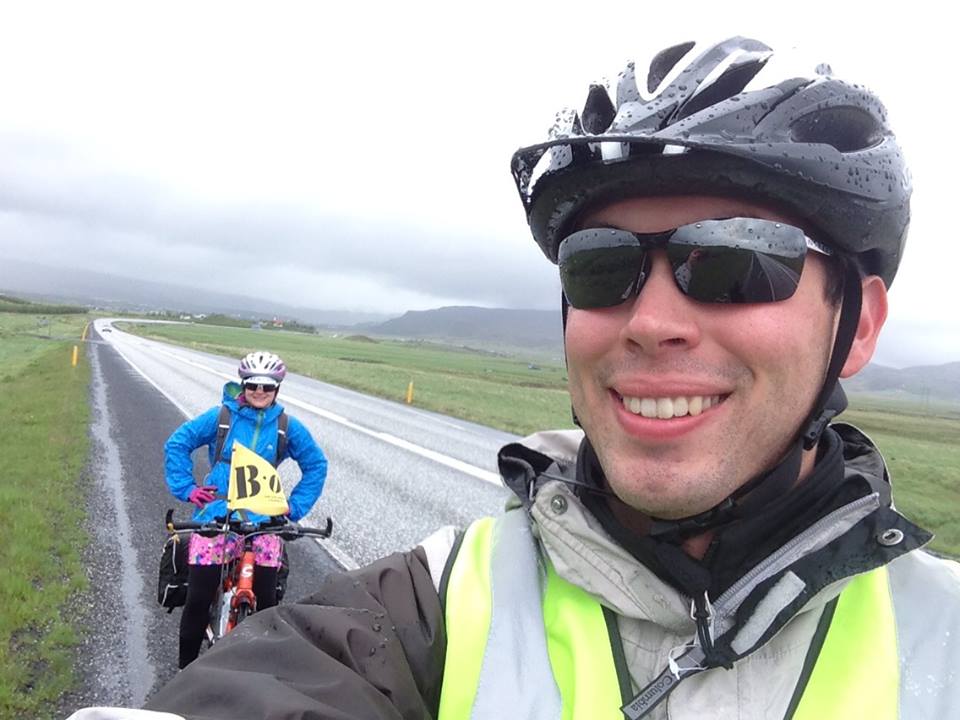

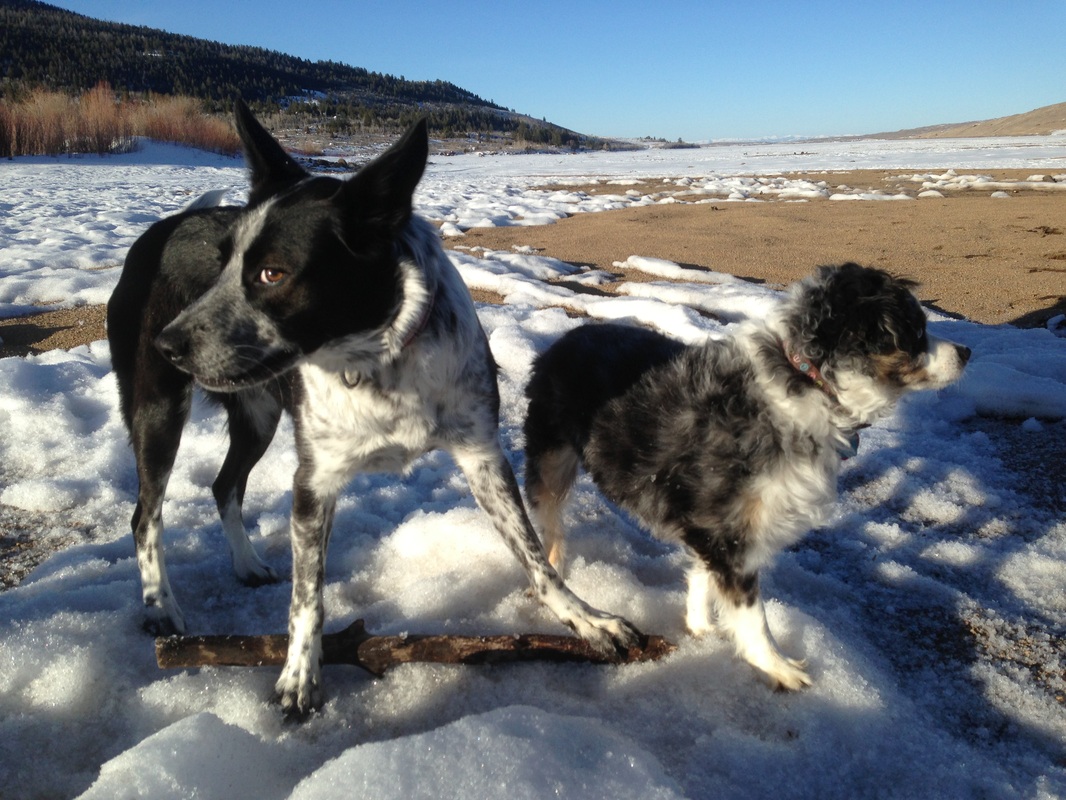
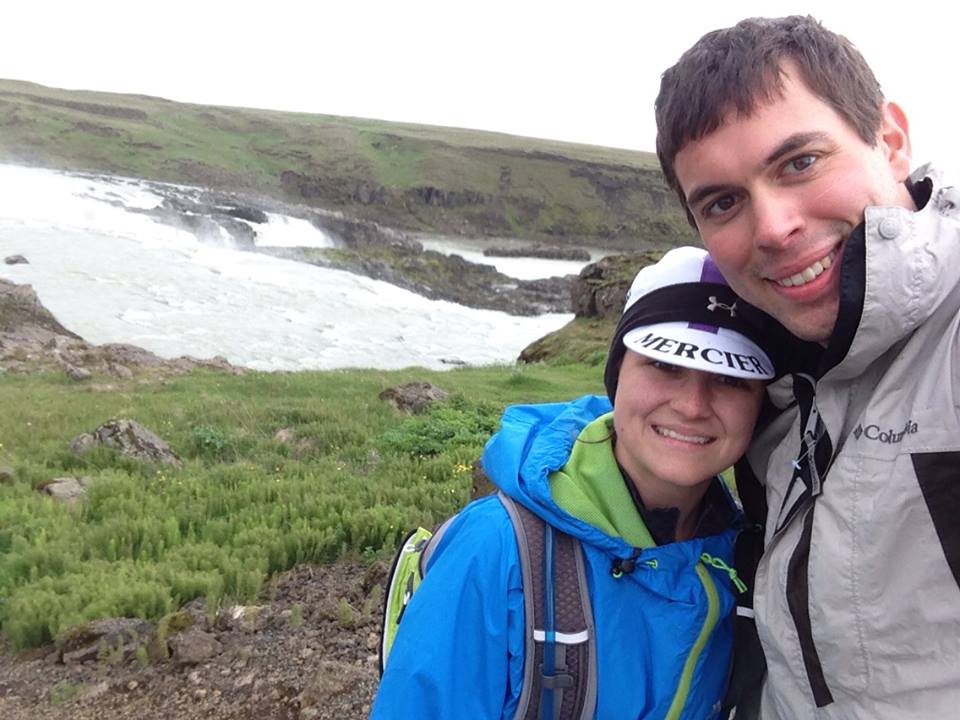
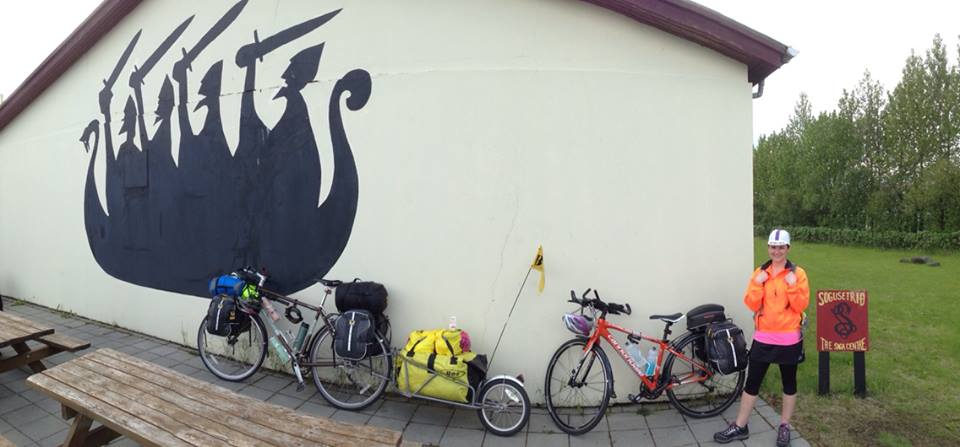


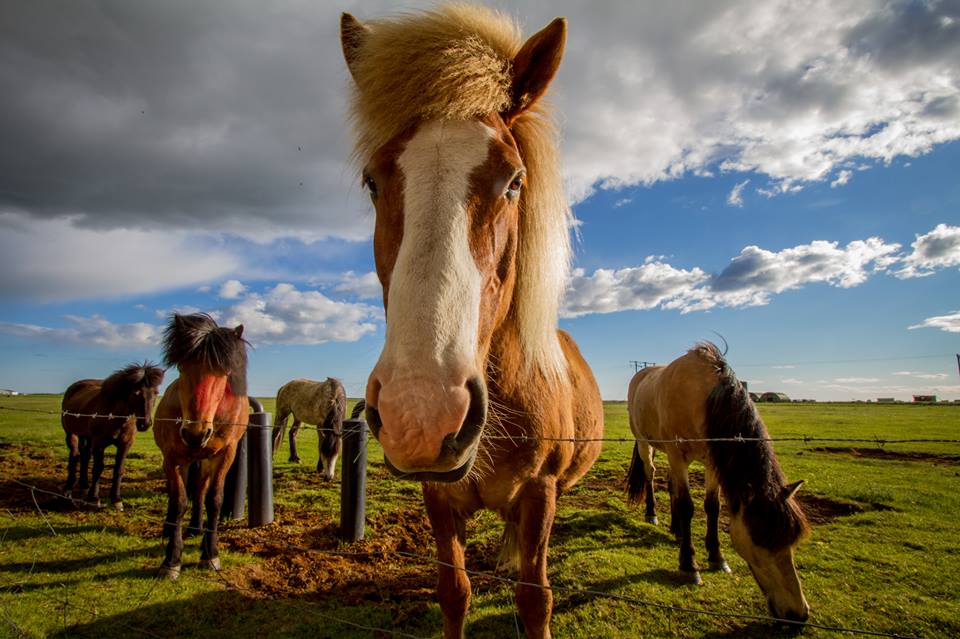
 RSS Feed
RSS Feed